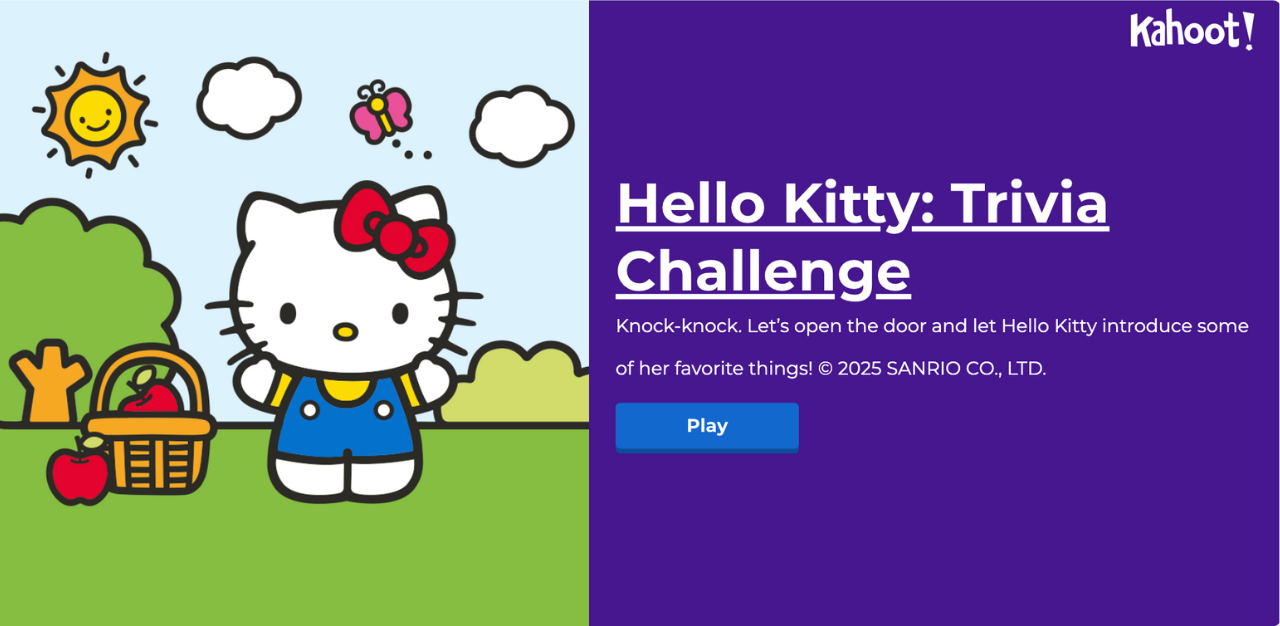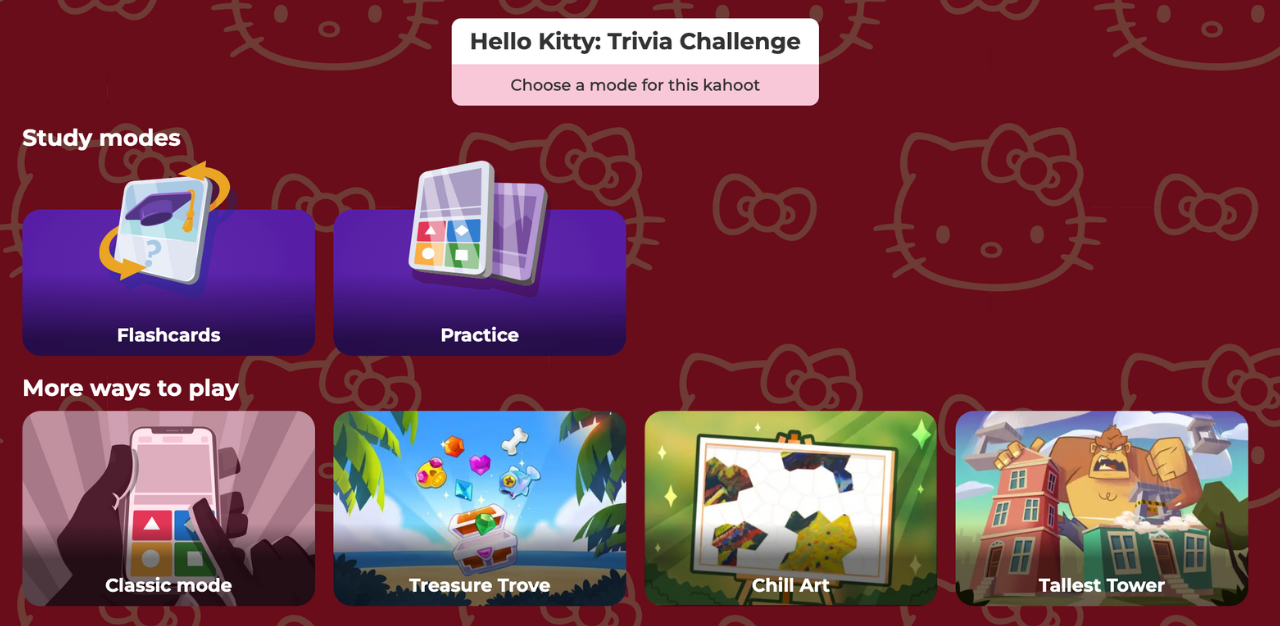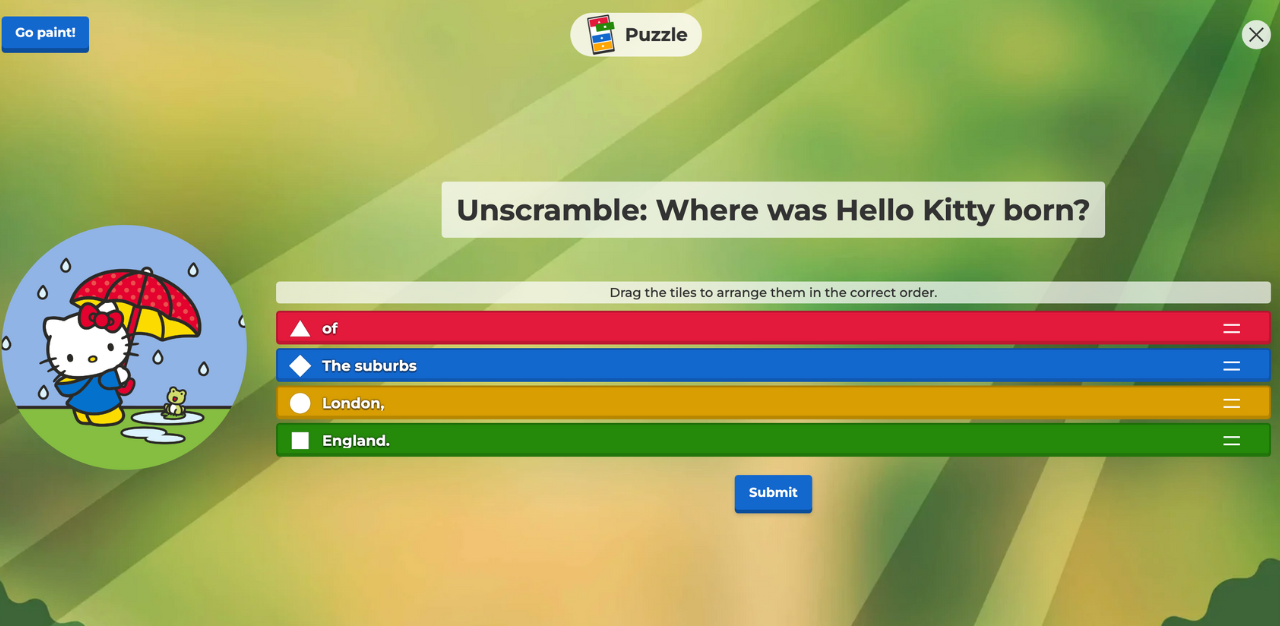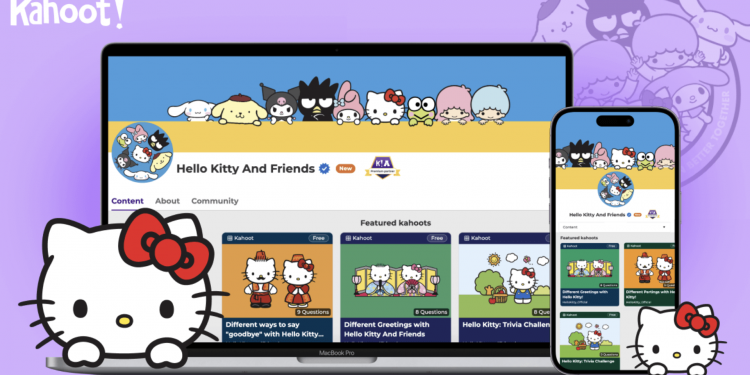Learning has come a long way from textbooks and chalkboards. Today, classrooms are becoming more interactive, engaging, and even playful—thanks to the power of gamification. One of the latest and most exciting developments in this space is Kahoot!’s partnership with Sanrio, bringing Hello Kitty and her friends into the world of educational games.
Announced on February 12, 2025, this collaboration introduces free educational games designed to make learning more fun and effective by using characters that students already know and love. With Singapore’s strong push for digital education, this initiative comes at the perfect time, blending entertainment and learning in a way that appeals to children, parents, and educators alike.

The Rise of Gamification: Why Learning Feels Like Playing
Gamification, the integration of game-like elements into non-gaming environments, has transformed the way students learn by making lessons more interactive and enjoyable. Educational platforms have increasingly adopted techniques such as point systems, leaderboards, and storytelling elements to boost engagement, but the incorporation of popular characters into these platforms represents an innovative step in making learning not just interactive, but also emotionally engaging.
Numerous studies support the effectiveness of gamification in education. A meta-analysis conducted by Sailer and Homner (2020) in Computers & Education found that gamification significantly enhances student motivation, engagement, and learning retention. Research published in the International Journal of Educational Technology in Higher Education (2021) highlights that game-based learning, when combined with cognitive engagement strategies, improves students’ ability to retain and apply knowledge. A separate study by Bai et al. (2020) in Educational Psychology Review found that gamified learning environments led to higher participation rates and increased academic performance compared to traditional lecture-based methods.
By integrating Sanrio’s well-loved characters, Kahoot! creates a bridge between entertainment and education, making learning experiences more relatable, personal, and memorable. The emotional connection that students form with their favourite characters enhances their willingness to engage with and absorb educational content in a meaningful way.

Why Pop Culture Works in Learning: Sanrio’s Role in the Classroom
The introduction of Hello Kitty and Friends on Kahoot! is more than just a fun addition to the platform; it is a strategic use of narrative-based learning. Studies have shown that storytelling elements significantly improve knowledge retention. A 2019 study in Educational Research Review found that students who learned through narrative-driven content demonstrated a 22% improvement in long-term recall compared to those using traditional methods. Another study from the Journal of Educational Psychology (2022) indicates that students who are emotionally invested in their learning materials tend to perform better on assessments.
By embedding Hello Kitty, My Melody, and other Sanrio characters into quizzes and storytelling-based challenges, Kahoot! fosters an environment where students feel emotionally connected to their learning journey. The concept of “joint media engagement,” introduced by Takeuchi and Stevens (2011) through research at the Joan Ganz Cooney Center, further supports this approach. Their study found that children who learn alongside familiar characters or engage with the same content as their parents experience higher levels of cognitive engagement. This suggests that character-based educational tools such as the Kahoot!-Sanrio collaboration can encourage both independent and collaborative learning experiences, whether in classrooms or at home.
Singapore’s Embrace of Digital Learning
Singapore has firmly established itself as a global leader in educational technology innovation. With government-backed initiatives promoting the integration of digital tools in education, the country is an ideal setting for collaborations such as the Kahoot!-Sanrio partnership. The Ministry of Education’s Transforming Education through Technology (EdTech) Masterplan 2030, launched in September 2023, sets the direction for incorporating technology into classrooms, emphasizing the use of AI-driven learning, personalized education tools, and gamified platforms to prepare students for a better digital future.
In collaboration with the Government Technology Agency (GovTech), MOE introduced the Student Learning Space (SLS) in 2018, a digital platform designed to provide curriculum-aligned resources across various subjects. This platform has evolved to include AI-driven features that personalize learning experiences, increase engagement through interactive simulations, and support inclusivity by catering to different learning styles. According to GovTech Singapore, AI-driven educational platforms offer a more immersive experience by integrating gamified content, interactive multimedia, and real-time learning feedback. These initiatives align with Singapore’s broader Smart Nation strategy, which seeks to integrate technology into everyday life, including education. By fostering digital literacy and embracing innovative EdTech solutions, Singapore continues to lead the way in modernizing learning environments, making it a receptive space for character-based learning collaborations.
Beyond Engagement: A Cross-Generational Learning Tool
One of the most unique aspects of the Kahoot!-Sanrio partnership is its ability to appeal across generations. Many parents and educators who grew up with Sanrio characters are now seeing these same figures reintroduced in a digital learning context for younger students. This nostalgic connection enhances engagement by creating shared learning experiences between different age groups.
The role of nostalgia in learning has been explored in research, showing that characters and media properties with long-standing cultural relevance can deepen learning connections. A 2017 study in the Journal of Children and Media by Rasmussen found that shared cultural references between parents and children led to more meaningful educational interactions. Similarly, research by the International Society for Technology in Education (ISTE, 2021) found that character-based learning tools can strengthen family engagement, increasing learning effectiveness at home. With parents and teachers having grown up alongside Sanrio characters, this collaboration provides a familiar touchpoint that not only engages students but also fosters learning as a shared experience.
The Future of Character-Based Learning: Where Do We Go from Here?
The Kahoot!-Sanrio collaboration could represent the beginning of a larger trend in character-driven education. Emerging technologies such as augmented reality (AR) and artificial intelligence (AI) are already being integrated into EdTech platforms, paving the way for even more immersive and personalized learning experiences.
Research by Garzón et al. (2019) in Interactive Learning Environments found that AR-based learning tools significantly improve engagement and long-term retention by offering interactive, hands-on educational experiences. Similarly, Holmes et al. (2018) in the British Journal of Educational Technology explored how AI-driven adaptive learning systems personalize education by responding to individual learning patterns. In another study, Kucirkova (2019) in the Journal of Children and Media found that characters that appear consistently across different media platforms help improve learning continuity and motivation.
The evolution of gamified learning, coupled with advances in technology, suggests that we may soon see AI-powered educational guides in the form of familiar characters or AR-driven lessons where students can interact with their favourite figures in real time. The success of Kahoot! and Sanrio’s collaboration may pave the way for future partnerships between educational platforms and major media franchises, further integrating pop culture into learning environments.

Final Thoughts: Making Learning More Fun and Accessible
The Kahoot!-Sanrio collaboration is more than just a fun idea—it represents the future of engaging, interactive learning. By blending beloved characters with educational content, it makes lessons more enjoyable, improves focus, and increases knowledge retention.
Singapore’s strong investment in EdTech and gamification means that innovations like this are here to stay. As digital learning continues to evolve, the question isn’t whether gamification will change education—it’s how quickly it will transform the classroom experience for generations to come.
So, whether you’re a student, a parent, or an educator, get ready to see more familiar characters pop up in your learning experiences—because in the world of education, the game is just getting started!
Beyond the Buzz: Measuring Real Impact
While gamification clearly drives engagement, education researchers emphasize that these tools must ultimately deliver meaningful learning outcomes. A comprehensive review by Dichev and Dicheva (2017) in the Educational Technology Research and Development journal found that the most effective implementations balance fun with substance, using game elements to reinforce rather than replace core educational content.
As character-based learning tools like the Kahoot!-Sanrio collaboration enter Singapore classrooms, their impact on both student engagement and academic achievement remains an important area for ongoing assessment. Researchers like Plass et al. (2020), writing in Educational Psychologist, suggest that the motivational benefits of game-based learning must be coupled with sound instructional design to maximize educational outcomes.
For now, Singapore students have the opportunity to learn alongside some of the world’s most recognizable characters—turning everyday lessons into potentially more engaging experiences that align with Kahoot!’s stated mission to “make learning awesome.”
RELATED: Osmo Action 5 Pro: Redefining Adventure Photography with Groundbreaking Features
Join the conversations on TheHomeGround Asia’s Facebook and Instagram, and get the latest updates via Telegram.














